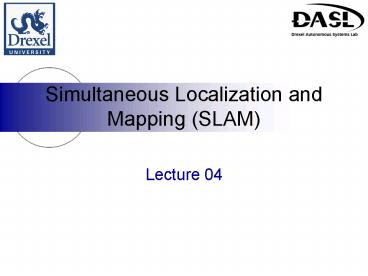Simultaneous Localization and Mapping SLAM - PowerPoint PPT Presentation
1 / 11
Title:
Simultaneous Localization and Mapping SLAM
Description:
Starting from t(0), make first prediction of where vehicle will be at t(0 Dt) ... Check to see if a new laser scan is available. If so, then move to step 8 ... – PowerPoint PPT presentation
Number of Views:283
Avg rating:3.0/5.0
Title: Simultaneous Localization and Mapping SLAM
1
Simultaneous Localization andMapping (SLAM)
- Lecture 04
2
SLAM Implementation
Step 1
- Derive vehicle model
- Translating our model to the laser point and
differentiating
3
SLAM Implementation
Step 1
- The vehicle model in discrete time is
- The velocity is measured with an encoder at the
back wheel, thus vc is
4
SLAM Implementation
Step 2
- Calculate the Jacobian (df/dx)
5
SLAM Implementation
Step 3
- Derive sensor model
- where xi and yi are the landmark locations
6
SLAM Implementation
Step 4
- Calculate the Jacobian (dh/dx)
where
7
SLAM Implementation
Step 5
- Initialize state vector
- Starting from t(0), make first prediction of
where vehicle will be at t(0 Dt)
8
SLAM Implementation
Step 6
- Initialize covariance matrix
- Initialize Q and W matrices
- Calculate prediction for covariance matrix
Initial estimates for x,y could be 0.1 meters off
while the angle could be 15 degrees off
9
SLAM Implementation
Step 7
- Check to see if new velocity and steering
measurements are available - If so, then update ve and a before next
prediction - If not, then use previous measurements for next
prediction - Check to see if a new laser scan is available
- If so, then move to step 8
- If not, then move to next iteration (i.e. t Dt)
10
SLAM Implementation
Step 8
- From a single 180 degree scan (SICK laser),
determine - The number of landmarks in a scan
- The center of each landmark
- For i 1 to the number of landmarks in a scan
- If current landmark is the first observed
landmark (i.e. states3) - Add x and y coordinate of new landmark to state
vector - Increase the size of all matrices (i.e. A is now
a 5x5 matrix) - Update state and covariance matrices
Where innov actual measurement predicted
measurement (from model)
11
SLAM Implementation
Step 9
- For i 1 to the number of landmarks in a scan
- If current landmark is NOT the first observed
landmark (i.e. statesgt3) - Estimate position of observation
- Compute distance between observation and all
landmarks already incorporated into state vector - Find landmark which is closest to observation
- If landmark is within 1 meter of observation,
assume it is the same landmark - Otherwise add observation as new landmark
- Update!
Where innov actual measurement predicted
measurement (from model)

